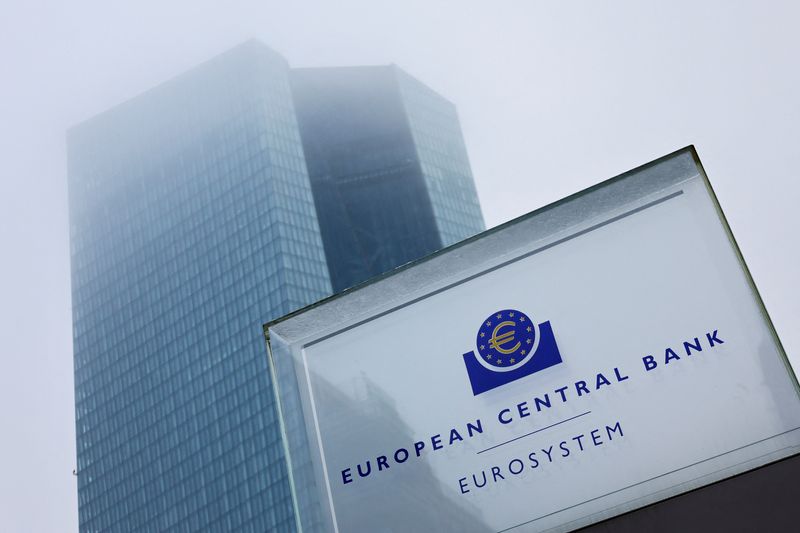
© Reuters. The constructing of the European Central Financial institution (ECB) is seen amid a fog earlier than the month-to-month information convention following the ECB’s financial coverage assembly in Frankfurt, Germany December 15, 2022. REUTERS/Wolfgang Rattay/File Picture
By Mike Dolan
LONDON (Reuters) – ‘Pushback’ has emerged as one of many monetary market phrases of the yr thus far, however ‘humility’ may properly take its place.
To various levels, high central bankers have this month tried to dampen what they see as overexcited rate of interest reduce expectations in markets for 2024. And so they’ve had some success – particularly in long run borrowing charges.
Warned once more this week by the Worldwide Financial Fund to “move cautiously” in opening a sluice gate of easing expectations with early charge cuts, Federal Reserve and European Central Financial institution officers have duly tried to prod markets away from assuming any preliminary easing earlier than June.
However cash markets have not given up the ghost simply but.
1 / 4 level Fed reduce is greater than absolutely priced by Could – with greater than a 50% likelihood of a transfer within the combine for March – and the primary ECB easing remains to be odds on by April.
All nonetheless to play for?
An attention-grabbing line within the minutes from the December ECB assembly nodded to retaining warning however instructed it could be smart to not rule something out simply but given the excessive diploma of financial uncertainty nonetheless at play.
“It was widely regarded as important not to accommodate market expectations in the post-meeting communication,” the ECB stated in a readout forward of its subsequent assembly subsequent week.
Nevertheless it added: “Some humility was advised with respect to judging market expectations given prevailing uncertainties.”
Whereas it is unclear whether or not it was advising humility by itself half or that of market merchants, it may probably be utilized to each.
12 months-end euphoria after the ECB’s Dec. 14 gathering noticed the markets scramble to cost an ECB charge reduce as quickly as March, solely to face ubiquitous ‘pushback’ since that is compelled them to nudge that again to April. That is remained the case whilst ECB chief economist Philip Lane just lately nodded to June on the earliest.
However similar to the Fed, the ECB additionally seems to be giving itself appreciable rhetorical wiggle room for the months forward.
‘R-STAR’ GAZING
Key to that could be a continued emphasis on retaining coverage ‘restrictive’ – in social gathering to bear down additional on what it sees as nonetheless extreme wage inflation, even because the underlying euro financial system flatlines and Germany toys with recession.
However retaining ‘restrictive’ coverage leaves a variety of choices open – not least to behave rapidly if the information turns.
Regardless of myriad caveats, central banks see restrictive coverage bearing down on progress, wages and costs as one the place coverage charges are above long-term ‘impartial’ and sustainable ranges that guarantee 2% inflation targets are met.
And for each the ECB and the Fed present charges are at the moment removed from these assumptions.
The Fed’s ‘dot plot’ of policymaker projections signifies a median assumption of the long-term impartial charge is 2.5% – nearly 290 foundation factors beneath present charges. As that assumes the true impartial charge – the fabled ‘r-star’ – remains to be simply 0.5%, then actual coverage charge restriction proper now’s nearly 200bps, relying on what present inflation charge reduce you employ.
Despite the fact that ECB officers are at pains to level out that ‘r-star’ is an unobservable and a slippery idea, their tough 2% assumption of long-term impartial – or a zero actual coverage charge – means present charges are at the least 100bps ‘restrictive’.
The crude upshot is that each central banks may comfortably reduce nominal coverage charges whereas persevering with to publicly insist, because the ECB minutes instructed on Thursday, that they’re going to keep “a restrictive stance for some time.”
ECB policymaker and Financial institution of France boss Francois Villeroy de Galhau opined on ‘r-star’ this week at a dialogue in Davos and stated that, whereas there was proof that it had stopped its 20-year downtrend the ECB estimated it to be “around zero”.
“If I look at nominal rates, we could expect them to be around 2%” by the cycle, he stated.
In fact the entire dialogue on actual coverage charges nonetheless hinges on progress on inflation – and there are cheap nerves that offer chain disruptions across the Pink Sea delivery may spur some costs once more early within the new yr.
However what’s additionally true is additional disinflation from right here will push actual coverage charges much more restrictive absent a reduce within the nominal charge – hardly what the ECB is in search of at this juncture.
Of the various ‘ifs’ and ‘buts’ about that, the primary central financial institution concern is that anticipation of nominal coverage charge easing flooring longer-term borrowing charges that would juice the financial system, spur lending and irk inflation earlier than the targets are met.
Therefore the cat and mouse recreation of current weeks.
For a lot of within the markets, continued weak euro zone progress and comfortable inflation will dominate and make it an inexpensive wager on an ECB transfer sooner quite than later.
Deutsche Financial institution strategists see the primary reduce in April and 150bps of cuts in 2024 as a complete – and assume the ECB will hit its inflation goal by midyear, properly forward of ECB forecasts for 2025. “We continue to expect the ECB to cut quickly to avoid an overtightening of the policy stance via a jump in real rates.”
Barclays’ Mariano Cena additionally expects 1 / 4 level reduce in April and 150bps of easing this yr. “If the ECB were to start cutting in June instead, we think that a 50bp cut during the summer is quite likely.”
However ING’s Carsten Brzeski says the ECB ought to subsequent week resist the temptation to maintain overreacting to market developments because it has in current months. “The irony of market pricing right now is that it makes the need for actual policy rate cuts less urgent.”
So each ‘pushback’ and ‘humility’ could co-exist as watchwords subsequent week – however ‘restrictive’ may cowl all bases forward.
The opinions expressed listed below are these of the creator, a columnist for Reuters.

